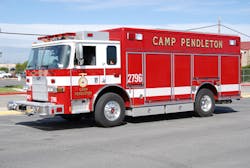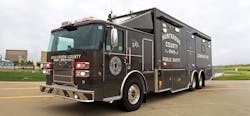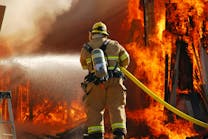The Camp Pendleton Marine Corps Base is located in Northern San Diego County with more than 17 miles of shoreline along the Pacific Ocean. The base was formed in April of 1942 on land that was founded originally by Spaniards who desired to establish Franciscan missions throughout California. The base was named in honor of Major Joseph H. Pendleton, who led the Marine Corps operations in southern California during his 46 years of service with the military and Marine Corps.
Today, the Camp Pendleton Marine Corps Base occupies more than 135,000 acres with a resident population of 50,000 military and dependant personnel, with an additional 60,000 personnel who work on the base. Camp Pendleton’s varied topography combined with the amphibious training areas, inland training ranges and airspace provides a great deal of flexibility for Marine Air Ground Task Forces that require a realistic training environment. With the expansion of our country’s military engagements in the Middle East, the Marine Corps has constructed several model towns that resemble the type of building construction and hazards that would be encountered by Marine forces when operating in these hazardous environments.
Fire And Emergency Service Department
The Camp Pendleton Fire and Emergency Services Department is under the command of Acting Fire Chief Jeffery Wilkerson, who oversees the department’s personnel who provide many unique services to the community. The department maintains automatic aid agreements with the neighboring departments in Oceanside, Orange County and with North County Fire, and responds to more than 4,000 incidents each year. The department maintains several specially training groups, including a swift-water rescue team, heli-tac operations, technical rescue group as well as a hazardous materials team.
The department operates from 10 strategically located fire stations, together with a seasonal brush station that is cross staffed with the United States Forest Service in Case Springs. The department operates nine engine companies, one ladder company, two rescue units and cross staffs a hazardous materials unit and a wide variety of brush apparatus. The Camp Pendleton fire apparatus fleet represents a unique mix of the different types of units that are in service with the Marine Corps Fire Service. Because of the significant wildland fire potential at the base, each station is equipped with both Type 3 and Type 4 brush units for responses.
Wildland Response Vehicles
The Type 3 brush unit fleet is impressive with a combination of Pierce Hawk model and larger 6x6 units built by Boise Mobile Equipment. The smaller Type 3 units are assigned to Stations 1, 2, 4, 5 and 6 and are built on International model 7400 four-door cab chassis and equipped with a Darley JMP fire pump rated at 500 gpm. An auxiliary diesel-driven fire pump rated at 185 gpm provides for pump and roll operations that are supported by the onboard 500-gallon water tank. A Foam Pro 2001 injection system supplies Class A foam from a 40-gallon water tank. These units were built on a short 179-inch wheelbase with an overall length of 24 feet, 7 inches.
Starting in 1997, the Marine Corps Fire Service began working on a brush truck design that would replace the venerable M-813-A-1 chassis that had been locally converted into brush fire vehicles and were in need of replacement. The result was the delivery of five International Paystar model 6x6 chassis with bodywork by Boise Mobile Equipment. These units provided enclosed seating for the crew and were equipped with a diesel-driven Hale fire pump rated at 100 gpm and carried 1,000 gallons of water together with a Robwen Class A foam system with a 20-gallon tank. These brush units are built on a 164-inch wheelbase and are powered by a Cummins diesel engine rated at 330 horsepower through an Allison HD-4560 automatic transmission. These vehicles are assigned to Stations 3, 7, 8, 9 and Station 28 in Case Springs.
Pumpers
The newest engine apparatus in the Camp Pendleton fleet was placed into service during 2010 and is assigned as Engine 2719 at the station protecting the Fallbrook Naval Weapons Station. This unit is a Pierce Contender four-door raised-roof cab powered by a Cummins ISL model engine rated at 425 horsepower with an Allison EVS-3000 transmission. The apparatus is built on a wheelbase of 185 inches with an overall length of 31 feet. Engine 2719 is equipped with a Waterous CS single-stage fire pump rated at 1,250 gpm with a 750-gallon water tank. A Pierce Husky 12 foam system is supplied by twin 30-gallon foam tanks.
The aluminum body is 152 inches long and is provided with full height body compartments on each side, together with enclosed storage for hard suction hose and ground ladders. Painted roll-up shutter doors are provided on each side and the rear body compartment to access equipment. The rear hose body is protected with lift-up aluminum tread plate hosebed covers. Scene lighting is provided by a Harrison 6-Kw hydraulic generator and Fire Research Optimum 900-watt lights installed at the front of the cab above the windshield and two at each side of the body. Emergency warning lights include a Code 3 model 2169A lightbar mounted on the cab roof, together with Code 3 LED lower zone lights and LED beacon lights at the rear hose body.
The apparatus carries four preconnected attack lines located at the front bumper, pump-panel area in speedlays hosebeds and a rear body 2.5-inch blitz line. Mounted above the fire pump is an Elkhart Vulcan model remote-control deck gun monitor rated at 1,250 gpm. Similar Pierce Contender pumpers have been acquired by the department and are currently assigned to Stations 3, 4, 5 and 8. All of Camp Pendleton’s front line apparatus are equipped with four-door cabs and the latest warning-light technology with future plans to acquire an additional new Pierce Contender engine for Station 7, which will be delivered later this year.
Rescue Squad
With the large size of the land area at Camp Pendleton, and the 17 miles of Interstate 5 highway that run through the base, there are numerous incidents requiring heavy and technical rescue equipment. A smaller rescue apparatus is assigned to Station 1 with Station 10 being home to Rescue 2796, a 2010 Pierce Arrow XT rescue squad. This unit replaced a Pierce Dash non-walk-in rescue apparatus that was designated for assignment to one of the Marine Corps overseas bases.
Rescue 2796 is built on a short 170-inch wheelbase with an overall length of 30 feet, 4 inches. This unit is powered by a Detroit Diesel Series 60 engine rated at 455 horsepower through an Allison EVS-4000 transmission and is equipped with Tak 4 independent front suspension with 17-inch disc brakes on the front axle. The unique two-door tilt cab carries a 20-foot aluminum non-walk-in rescue body with painted roll-up shutter doors.
There are 11 lower body compartments, with four top locker compartments that can be accessed with a pull-down ladder assembly. The front bumper is equipped with small-tool compartments together with a Warn electric winch rated at 12,000 pounds. An Onan 25-Kw power take-off driven generator supplies power to a cable reel, a 9,000-watt Wilburt Night Scan light tower, together with two Fire Research 1,000-watt tripod lights. The rescue body is also equipped with two hydraulic reels and one low-pressure air reel, together with multiple shelves, slide-out trays and body-mounted winch receivers.
The Camp Pendleton Fire and Emergency Services operates a well-designed fleet of apparatus and provides excellent fire and rescue services to the civilian and military personnel at the base. Appreciation is extended to Acting Fire Chief Jeffery Wilkerson who assisted in making arrangements for fire station visits and apparatus photographs.
TOM SHAND is a 37-year veteran of the fire service having served with departments in Maryland, Pennsylvania and New York. He has worked in the fire apparatus industry since 1985, including 15 years with Saulsbury Fire Apparatus. He is a contributing editor to Fire Apparatus Journal and Firehouse Magazine and works with Mike Wilbur at Emergency Vehicle Response. He co-hosts the Apparatus Architects podcast with Wilbur, based on their column in Firehouse Magazine.









